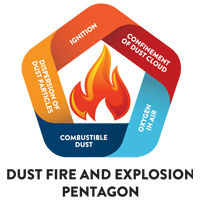In a food processing facility, there are some hazards that can be easily spotted with the human eye: a color-coded tool in the wrong portion of the plant, a visibly-soiled food contact surface, a leaking/corroded hose, etc. However, there are a plethora of hidden and sometimes even invisible threats looming. One potentially fatal threat in food facilities that may linger out of sight is DUST.
 What is combustible dust?
What is combustible dust?NFPA 652 defines combustible dust as a “finely divided combustible particle solid that presents a flash fire hazard or explosion hazard when suspended in air of the process-specific oxidizing medium over a range of concentrations.” This applies to all facilities that manufacture, blend, package, repackage, convey, handle combustible dust, or particulate solids that may become dust.
When the following elements combine at the same time, there is risk of a dust explosion:
There are also some materials that become combustible only when in dust form. Keep in mind that after a first explosion, dust is dispersed into the air, which could result in a more deadly, secondary explosion.
Food product materials were responsible for a whopping 44.3% of fires and explosions. These numbers easily overshadow other materials like metal, coal, paper, plastic, carbon, etc. (24.1% is represented by the next most present material: wood products).
Even more troubling is that it's not easy to pin down just one or two culprits when examining materials in a food manufacturing plant. Instead, all materials need to be thought about holistically. As OSHA describes, “Any combustible material can burn rapidly when in a finely divided form. If such dust is suspended in the air in the right concentration, under certain conditions, it can become explosible. Even materials that do not burn in larger pieces (such as aluminum or iron), given the proper conditions, can be explosible in dust form.”
Nelson-Jameson works closely with Delfin Industrial Vacuums to anticipate and meet customer needs when it comes to dust concerns. Our partnership allows us to combine a wide range of highly engineered dust mitigation equipment with the most tenured technical experts known in the food market. By creating this partnership, Nelson-Jameson, and Delfin are able to reduce your risk while suggesting certified solutions in compliance with NFPA guidelines and OSHA requirements for TOTAL DUST MITIGATION.
Designed for people who assess and manage plant operations, including:
Safety Directors, Plant Managers, Quality Control, Production Managers, Environmental Health & Safety Managers, Engineering, Maintenance, Sanitation and Purchasing departments. Perfect for processing facilities, manufacturing plants, and other environments that can generate combustible dust.

December 1, 2025
Nelson-Jameson understands that efficiency and worker safety are equally important goals in food manufac...

November 26, 2025
For food manufacturers, a lapse in either worker safety or food safety can initiate a domino effect. It ...

November 26, 2025
Ensuring worker safety and maximizing operational efficiency are not mutually exclusive goals in a food ...